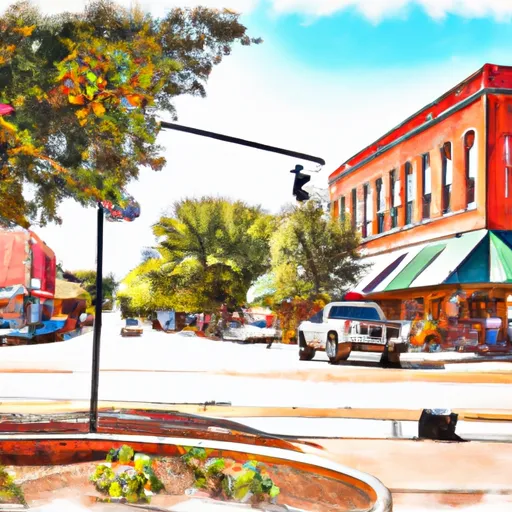-
 Snoflo Premium
Snoflo Premium
Get unlimited access to all our content
With no Ad interruptions! - Start Your Free Trial Login with existing account
Caddo
Eden Index
Climate
9.8
•
Recreation
2.7
•
Community
•
Safeguard
4.9/10

Caddo, Texas is located in the southern part of the state and has a subtropical climate with hot summers and mild winters. The area receives around 35 inches of rainfall annually, with the wettest months being April and May.
The hydrology constituents of Caddo are primarily made up of the Caddo Lake and the Big Cypress Bayou. These bodies of water provide opportunities for fishing, boating, and birdwatching.
Outdoor recreation opportunities in Caddo also include hiking in the Caddo Lake State Park and exploring the historic downtown area. Visitors can enjoy local restaurants, art galleries, and boutique shops, while also experiencing the natural beauty of the area.
What is the Eden Index?
The Snoflo Eden Index serves as a comprehensive rating system for regions, evaluating their desirability through a holistic assessment of climate health, outdoor recreation opportunities, and natural disaster risk, acknowledging the profound impact of these factors on livability and well-being.
Climate Health Indicator (CHI): 9.8
Caddo receives approximately
760mm of rain per year,
with humidity levels near 74%
and air temperatures averaging around
18°C.
Caddo has a plant hardyness factor of
8, meaning
plants and agriculture in this region tend to thrive here all year round.
By considering the ideal temperature range, reliable water supplies, clean air, and stable seasonal rain or snowpacks, the Climate Health Indicator (CHI) underscores the significance of a healthy climate as the foundation for quality living.
A healthy climate is paramount for ensuring a high quality of life and livability in a region, fostering both physical well-being and environmental harmony. This can be characterized by ideal temperatures, reliable access to water supplies, clean air, and consistent seasonal rain or snowpacks.
Weather Forecast
Streamflow Conditions
Middle Brazos-Bosque
Area Rivers
Middle Brazos-Bosque
Snowpack Depths
Middle Brazos-Bosque
Reservoir Storage Capacity
Middle Brazos-Bosque
Groundwater Levels
Recreational Opportunity Index (ROI): 2.7
The Recreational Opportunity Index (ROI) recognizes the value of outdoor recreational options, such as parks, hiking trails, camping sites, and fishing spots, while acknowledging that climate plays a pivotal role in ensuring the comfort and consistency of these experiences.
Access to outdoor recreational opportunities, encompassing activities such as parks, hiking, camping, and fishing, is crucial for overall well-being, and the climate plays a pivotal role in enabling and enhancing these experiences, ensuring that individuals can engage in nature-based activities comfortably and consistently.
Camping Areas
| Campground | Campsites | Reservations | Toilets | Showers | Elevation |
|---|---|---|---|---|---|
| Promontory - Proctor Lake | 85 | 1,226 ft | |||
| Sowell Creek - Proctor Lake | 60 | 1,212 ft | |||
| De Leon Community Park | None | 1,282 ft | |||
| Dam - Leon Reservoir | None | 1,387 ft | |||
| Fort Belknap County Park | None | 1,178 ft | |||
| Copperas Creek - Proctor Lake | 65 | 1,217 ft | |||
| Ringling Lake City Park | None | 1,473 ft | |||
| Firemans City Park - Graham | 14 | 1,024 ft | |||
| Possum Kingdom State Park | 16 | 1,070 ft | |||
| Lake Daniel City Park | None | 1,309 ft |
Catastrophe Safeguard Index (CSI):
The Catastrophe Safeguard Index (CSI) recognizes that natural disaster risk, encompassing floods, fires, hurricanes, and tornadoes, can drastically affect safety and the overall appeal of an area.
The level of natural disaster risk in a region significantly affects safety and the overall livability, with climate change amplifying these risks by potentially increasing the frequency and intensity of events like floods, fires, hurricanes, and tornadoes, thereby posing substantial challenges to community resilience and well-being.
Community Resilience Indicator (CRI):
The Community Resilience Indicator (CRI) recognizes that education, healthcare, and socioeconomics are crucial to the well-being of a region. The CRI acknowledges the profound impact of these elements on residents' overall quality of life. By evaluating educational resources, healthcare accessibility, and economic inclusivity, the index captures the essential aspects that contribute to a thriving community, fostering resident satisfaction, equity, and social cohesion.

